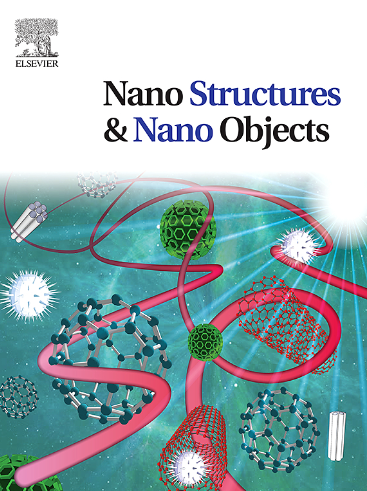利用 Kigelia africana (lamb) benth 叶提取物绿色制备新型 LaCeO₃ 并用 CuO 进行装饰,用于光催化降解孔雀石绿
IF 5.45
Q1 Physics and Astronomy
引用次数: 0
摘要
本研究采用绿色合成方法,成功合成了一种新型LaCeO3/CuO纳米复合材料。LaCeO3是一种钙钛矿,带隙值在3 ~ 3.19 eV之间。CuO是一种具有1.2-2 eV的低带隙的低成本材料,其结合旨在减小整体带隙。这种材料改性将产生异质结结构,从而提高其光催化性能。FT-IR、UV-Vis DRS、XRD、HR-TEM、FESEM-EDX和XPS等表征技术验证了该纳米复合材料的有效性,该复合材料具有独特的形貌和S型异质结结构。LaCeO3/CuO纳米复合材料的带隙能量为2.88 eV,处于可见光光谱范围内。光催化性能测试表明,LaCeO3/CuO纳米复合材料在可见光下有效分解孔雀石绿(MG),在120 分钟内达到92.88 %的最大降解效率。动力学研究表明,该反应遵循准一级动力学,其速率常数为6.19 × 10⁻²min⁻¹ 。光催化剂降解MG的理想质量为30 MG。研究还考察了pH、阴离子的存在以及活性氧(ROS)的作用等各种因素对光催化活性的影响。结果表明,LaCeO3/CuO纳米复合材料在中性至温和碱性条件下表现出最佳性能。阴离子的存在,特别是Cl - 4和SO₄²-对光催化活性有负面影响。此外,LaCeO3/CuO纳米复合材料表现出优异的可重复使用性,在连续三个循环中保持较高的降解效率。这些结果强调了绿色合成的LaCeO3/CuO纳米复合材料作为有效去除废水中有机污染物的有前途和可持续的光催化剂的可能性。本文章由计算机程序翻译,如有差异,请以英文原文为准。
Green fabrication of novel LaCeO₃ decorated with CuO using Kigelia africana (lamb) benth leaf extract for photocatalytic degradation of malachite green
This study successfully synthesized a novel LaCeO3/CuO nanocomposite using a green synthesis method mediated by Kigelia africana leaf extract (KALE). LaCeO3 is a perovskite with a significantly high band gap value between 3 and 3.19 eV. The combination with CuO, a cost-effective material that has a lower band gap of 1.2–2 eV, aims to reduce the overall band gap. This material modification will result in a heterojunction structure that boosts its photocatalytic performance. Characterization techniques such as FT-IR, UV-Vis DRS, XRD, HR-TEM, FESEM-EDX, and XPS validated the effective creation of the nanocomposite, which exhibited a unique morphology and a type S heterojunction structure. The LaCeO3/CuO nanocomposite exhibited a bandgap energy of 2.88 eV, placing it within the visible light spectrum. Experiments assessing its photocatalytic performance demonstrated that the LaCeO3/CuO nanocomposite effectively decomposed malachite green (MG) under visible light, achieving a maximum degradation efficiency of 92.88 % within 120 minutes. Kinetic investigations indicated that the reaction follows pseudo-first-order kinetics, exhibiting a rate constant of 6.19 × 10⁻² min⁻¹ . The ideal mass of the photocatalyst for the degradation of MG was found to be 30 mg. The study also investigated the influence of various factors, such as pH, the presence of anions, and the role of reactive oxygen species (ROS), affected photocatalytic activity. Results indicated that the LaCeO3/CuO nanocomposite exhibited optimal performance in neutral to mildly alkaline conditions. The presence of anions, particularly Cl⁻ and SO₄²⁻, negatively impacted photocatalytic activity. Furthermore, the LaCeO3/CuO nanocomposite demonstrated excellent reusability, maintaining high degradation efficiency over three consecutive cycles. These results emphasize the possible of the green-synthesized LaCeO3/CuO nanocomposite as a promising and sustainable photocatalyst for the effective removal of organic pollutants from wastewater.
求助全文
通过发布文献求助,成功后即可免费获取论文全文。
去求助
来源期刊

Nano-Structures & Nano-Objects
Physics and Astronomy-Condensed Matter Physics
CiteScore
9.20
自引率
0.00%
发文量
60
审稿时长
22 days
期刊介绍:
Nano-Structures & Nano-Objects is a new journal devoted to all aspects of the synthesis and the properties of this new flourishing domain. The journal is devoted to novel architectures at the nano-level with an emphasis on new synthesis and characterization methods. The journal is focused on the objects rather than on their applications. However, the research for new applications of original nano-structures & nano-objects in various fields such as nano-electronics, energy conversion, catalysis, drug delivery and nano-medicine is also welcome. The scope of Nano-Structures & Nano-Objects involves: -Metal and alloy nanoparticles with complex nanostructures such as shape control, core-shell and dumbells -Oxide nanoparticles and nanostructures, with complex oxide/metal, oxide/surface and oxide /organic interfaces -Inorganic semi-conducting nanoparticles (quantum dots) with an emphasis on new phases, structures, shapes and complexity -Nanostructures involving molecular inorganic species such as nanoparticles of coordination compounds, molecular magnets, spin transition nanoparticles etc. or organic nano-objects, in particular for molecular electronics -Nanostructured materials such as nano-MOFs and nano-zeolites -Hetero-junctions between molecules and nano-objects, between different nano-objects & nanostructures or between nano-objects & nanostructures and surfaces -Methods of characterization specific of the nano size or adapted for the nano size such as X-ray and neutron scattering, light scattering, NMR, Raman, Plasmonics, near field microscopies, various TEM and SEM techniques, magnetic studies, etc .
 求助内容:
求助内容: 应助结果提醒方式:
应助结果提醒方式:


